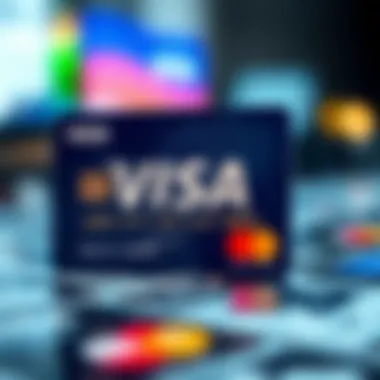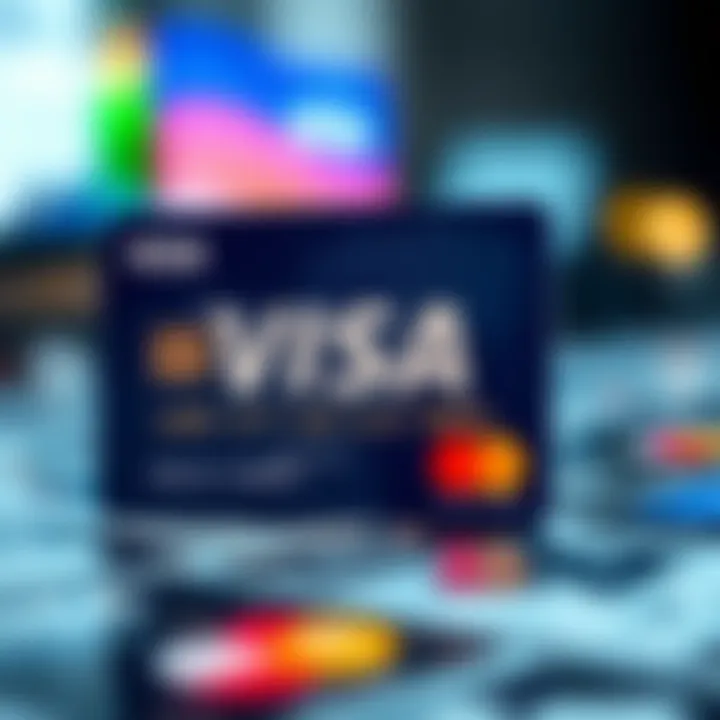An In-Depth Guide to Visa Cards and Their Benefits


Intro
Visa cards have become ubiquitous in today’s financial landscape, offering a realm of conveniences to consumers and businesses alike. This guide seeks to demystify the myriad of aspects surrounding Visa cards, and it’s essential to start with an understanding of key terms and concepts that shape the Visa payment ecosystem. From understanding the types of Visa cards to unraveling their benefits, this narrative will unfold the important factors that influence consumer choices while managing finances effectively. With a foundation built on clarity and insight, readers will be well-equipped to navigate their financial journeys with Visa at their side.
Key Terms and Definitions
When diving into the world of Visa cards, one needs to become familiar with specific terminology that often accompanies discussions about credit, debit, and prepaid cards. Knowing these terms enhances understanding and aids in informed decision-making. Here are some vital definitions:
- Credit Limit: This is the maximum amount a cardholder can borrow on their credit card. Understanding your limit can influence how you manage payments and spending effectively.
- Interest Rate: Often referred to as the Annual Percentage Rate (APR), this is the price of borrowing funds from your card provider. It’s crucial to know how interest accumulates on any outstanding balance to avoid financial pitfalls.
- Cash Back: This is a popular feature where a percentage of the purchases made with the card is returned to the cardholder. Depending on the card's terms, this can add significant value over time.
- Reward Points: Points are accumulated based on spending, which can be redeemed for various benefits, including travel, merchandise, or even statement credits.
- Foreign Transaction Fees: These are charges imposed when you use your card for purchases outside your home country, and understanding them is vital for frequent travelers.
Practical Applications of Investment Terms
Understanding key investment terms and how they relate to Visa cards can streamline the decision-making process. For instance:
- When evaluating the cost-effectiveness of a Visa card, analysing rewards vs interest rates is crucial. Some cards offer excellent rewards but come with high interest rates that could diminish those benefits if you carry a balance.
- For international travelers, research into foreign transaction fees can help choose a card that minimizes costs abroad. Having a Visa card with lower or no fees can make a significant difference in expenses while travelling.
- Additionally, knowing your credit limit can critically influence how you manage spending day-to-day, making budgeting an easier task.
Expert Advice
As with any financial decision, expert insights can dramatically influence the outcome of selecting a Visa card.
Strategic Insights for Different Investment Types
Different types of Visa cards cater to various consumer needs. Here’s a breakdown:
- Credit Cards generally offer flexibility and can help build a good credit score if used responsibly. They are ideal for those who can pay the balance each month to avoid interest.
- Debit Cards are connected directly to a checking account, allowing for real-time spending monitoring. They are suitable for budget-conscious users who want to avoid debt.
- Prepaid Cards come with a set limit of funds loaded beforehand. They’re particularly useful for those who wish to control spending without the risk of overextending themselves.
Tips for Evaluating Financial Products
Evaluating Visa cards should involve a careful assessment of several factors:
- Look closely at the annual fees associated with the card. A high fee can negate the benefits of rewards unless there are significant perks that justify it.
- Consider the security features offered. In an age where digital fraud is prevalent, knowing what security measures a card possesses can provide peace of mind while transacting.
- Don’t forget to check for customer service ratings. A card with responsive support can make a world of difference when issues arise.
"Understanding the ins and outs of financial products is not just about numbers. It’s about safeguarding your financial future."
With these tools and insights at your disposal, you are now better prepared to explore the benefits and features of Visa cards, ultimately leading to informed decisions that align with your financial goals.
For further exploration, you can refer to resources such as Wikipedia, Britannica, or community discussions on Reddit.
Stay tuned for the next section, which will delve deeper into the different types of Visa cards available and how they cater to varying consumer needs.
Understanding Visa Cards
Understanding Visa cards is pivotal in today’s financial landscape. These cards are more than just plastic; they symbolize access to credit, convenience, and financial security. For both individuals and investors, grasping the nuances of Visa cards could mean the difference between making informed spending choices and getting caught in a web of fees and debt.
Every card has a story and knowing more about Visa cards helps in making well-informed decisions when it comes to managing personal finances. It’s essential to recognize how these cards can influence spending habits, aid in building credit history, and also provide features that can enhance one’s financial life.
Origins of Visa
The tale of Visa begins in the late 1950s, igniting a transformation in how people made purchases. Originally launched as the BankAmericard in 1958, this card was the brainchild of Bank of America. Its primary aim was to facilitate transactions in a growing consumer economy. As card usage surged, the demand for an expanded network grew, leading to the crafting of a brand recognized globally.
By 1976, the name ‘Visa’ was adopted, which emphasized its vision of international access. This restructuring was crucial as it opened doors to various economies and markets around the world, establishing Visa as a leader in the payment card industry. Since then, it has evolved significantly, integrating state-of-the-art technology to enhance user experience.
What is a Visa Card?
In simple terms, a Visa card is a financial product that allows cardholders to access funds via credit or debit. They are universally accepted in millions of places, enabling seamless transactions across borders. What separates Visa cards from others is not just their widespread use but the backend technology that supports them. This ensures that transactions are processed quickly and securely, making shopping experiences smooth.
For anyone interested in personal finance or investment, understanding how Visa operates is fundamental. It involves learning about both the practicality and security aspects of these cards, which play an integral role in everyday financial dealings.
Different Types of Visa Cards
Visa cards come in varied forms, each catering to different needs.
Credit Cards
Credit cards provide the ability to borrow money up to a particular limit set by the issuer, making them a handy tool for everyday expenses. Users can pay off their balances later, which can help build a positive credit history. A significant feature is the grace period, allowing cardholders to avoid interest if balances are cleared in full by the due date. Still, it's crucial to keep spending in check to avoid accumulating debt—a common pitfall many experience. Credit cards often come with additional perks like travel insurance or rewards programs, making them a desirable option for frequent travelers.
Debit Cards
Debit cards, on the other hand, pull directly from the user’s bank account, which makes them a safer option for those wary of overspending. A key characteristic lies in the direct connection with one’s financial resources, thus minimizing the risk of accumulating debt. However, since funds are directly deducted, there’s often no leeway if an account is drained. Debit cards are generally more straightforward and thus are an excellent choice for budgeting. They may lack some of the rewards or benefits that credit cards offer, which can be a determining factor for users.
Prepaid Cards
Prepaid cards function similarly to debit cards but can offer additional flexibility as they are not linked to a bank account. Instead, users load money onto these cards in advance. This feature is particularly useful for budgeting, as it sets spending limits. However, some prepaid cards may come with fees for loading funds or withdrawing cash. They serve as an entry point for those who may not qualify for traditional credit or debit cards, making them a popular choice among younger users or those looking to control spending.
“Understanding the complexity of Visa cards and their types is crucial for both personal finance management and strategic investment decisions.”
Key Features of Visa Cards
Visa cards have set themselves apart in the financial landscape, boasting features that appeal to a wide audience, from casual users to seasoned financiers. Understanding these key features allows individuals to harness the full potential of these cards. The most influential aspects include their global acceptance, enticing rewards programs, and robust security measures. Each of these features not only improves user experience but also ensures that using a Visa card is a sound decision for managing finances effectively.


Global Acceptance
One of the standout features of Visa cards is their global acceptance. They are accepted at millions of locations worldwide, making them exceedingly versatile. Whether you're strolling through the streets of Paris or shopping online for goods in New Zealand, chances are a Visa card will suffice. This universality eliminates the hassle of currency exchanges or carrying cash in unfamiliar places.
When traveling, having a widely accepted card is crucial. It saves you the headache of being left without a viable payment option or paying exorbitant service fees to convert currency. From busy urban centers to remote destinations, Visa’s presence helps ensure that your purchasing power remains intact wherever you find yourself.
Rewards and Cashback Programs
Many Visa cards come with rewards and cashback programs, which are attractive incentives for consumers. These programs allow cardholders to earn points, miles, or cash back on every dollar spent, creating a win-win situation. By simply using your Visa card for everyday purchases, you can accrue benefits that translate into real value.
- Cashback: Some cards offer a percentage of your spending back to you, which can significantly lessen your overall expenses when used wisely.
- Points and Miles: Other rewards systems allow you to gather points or travel miles that can be redeemed for future purposes—like discounts on flights or hotel stays.
Such features not only enhance the appeal of Visa cards but also encourage more responsible spending habits. When you know you'll receive something back for your purchases, it motivates you to utilize your card rather than just cash.
Enhanced Security Features
Today’s technological landscape necessitates stringent security measures, and Visa has ensured that enhanced security features are paramount. Among the most notable of these are the chip technology and contactless payments.
Chips and Contactless Payments
Chips embedded in Visa cards are designed to provide a greater level of security than traditional magnetic stripes. They generate unique codes for every transaction, making it exceedingly challenging for fraudsters to duplicate or steal card information.
Contactless payments, on the other hand, allow for quick transactions by simply tapping your card at the point of sale, which not only saves time but also reduces the risk of card skimming, as you don't have to insert or swipe your card. These innovations have made Visa cards a popular choice for those who prioritize not just convenience but safety as well. However, it’s always wise to remain vigilant and monitor account transactions regularly.
Fraud Protection Mechanisms
The mechanisms in place for fraud protection are equally vital for Visa card users. When suspicious activity is detected, Visa's fraud monitoring systems notify cardholders immediately, allowing for quick action to mitigate potential losses. Additionally, cardholders often have the option to disable their cards or set purchasing limits via mobile apps.
A unique characteristic of Visa's fraud protection is the feature of zero liability, which means you won’t be held responsible for unauthorized transactions if you report them promptly. This aspect may put Visa cards above others in terms of security and peace of mind for users—knowing that your finances are being monitored and protected.
"With Visa's comprehensive security mechanisms, one can purchase or travel around the globe with a layer of assurance that is difficult to replicate."
In summary, the key features of Visa cards—from global acceptance to innovative security protocols—make them a practical choice for various financial needs. Understanding these elements can help individuals make informed decisions about how best to use their cards, maximizing benefits while minimizing risks.
Benefits of Using a Visa Card
Using a Visa card brings a plethora of advantages that cater to both casual shoppers and serious investors alike. Delving into the benefits highlights how this financial tool can enhance daily transactions, facilitate budgeting, and even contribute to long-term financial health. The importance of these aspects can't be overstated, as each benefit plays a distinct role in shaping the user’s financial experience and acumen.
Convenience and Accessibility
One of the hallmark features of Visa cards is their unmatched convenience. Having a Visa card in your wallet is akin to having cash, but with a modern twist. When you swipe your card at checkout or enter your card information online, you're not just making a purchase; you're enjoying a level of ease that cash simply cannot provide.
- Global Reach: Whether you’re wandering through the bustling streets of Tokyo or shopping in a quaint market in Lisbon, Visa is accepted in over 200 countries. This global acceptance means that you don’t have to fret about currency exchange or carrying large amounts of cash while traveling.
- 24/7 Availability: Visa cards can be used anytime, anywhere. Plus, the online banking facilities allow you to manage your account, check your balance, and make payments regardless of the hour. Need to pay a bill at midnight? No problem, it's all just a click away.
Visa cards also come with added perks like special offers or discounts from various retailers, making shopping more lucrative. In the fast-paced world we live in, the convenience of using a Visa card translates to efficient financial management, eliminating the long lines often associated with cash transactions.
Building Credit History
Having a Visa card isn’t just about spending; it also plays a crucial role in building and maintaining credit history. This is particularly significant for young individuals or those new to the credit world, as a solid credit history can unlock numerous doors.
- Establishing Credit: For those unfamiliar with credit, using a Visa card responsibly can help establish a credit history. Making timely payments on purchases reflects positively to credit bureaus, which is essential for anyone looking to secure loans or mortgages.
- Credit Score Impact: As credit scores are often vital for major purchases like homes or cars, having a Visa card can impact this score directly. Responsible card use, such as maintaining a low balance and paying on time, can show lenders that you're a trustworthy borrower.
Hence, Visa cards can be a stepping stone toward financial trustworthiness and increased opportunities.
Financial Management Tools
Visa cards come equipped with a range of tools that allow cardholders to manage their finances effectively. These tools are more than just neat features; they’re essential for those who want to keep their spending in check and plan for their future.
- Spending Alerts: Most Visa card providers offer customizable spending alerts that notify you when you approach your budget limit. This can help curb impulsive buying behavior and promote responsible spending.
- Budgeting Tools: Some Visa cards give access to budgeting tools that categorize your spending. Seeing where your money goes can provide clarity and help in adjusting your financial habits accordingly.
- Track Rewards: For users enrolled in rewards programs, keeping tabs on accumulated points can also be managed through the card issuer's site or app. This tracking can serve as a motivator to use the card more often, ideally in a responsible way.
In summary, the benefits of using a Visa card extend far beyond its immediate utility. The convenience, capability to build credit, and various financial management tools available make it an indispensable part of modern financial life. Understanding these benefits can help consumers make informed decisions about how to leverage Visa cards to their advantage.
"With the right tools and habits, a Visa card is not just a piece of plastic, it’s a gateway to better financial health and savvy management."
For more information on managing credit and personal finance, you could visit Investopedia or check the Consumer Financial Protection Bureau.
Visa Card Application Process
Navigating the Visa card application process is an essential step for anyone considering entering the world of credit and debit cards. Not only does it provide access to immediate purchasing power, but it also opens doors to various financial services designed to enhance everyday living. As such, understanding this process can empower users to make informed decisions, safeguard against potential pitfalls, and tailor their choice of card to meet their individual financial needs.
Eligibility Criteria
When diving into the eligibility criteria for obtaining a Visa card, applicants should start by taking a close look at their financial background. Generally, banks or financial institutions will assess several factors to determine if one qualifies. These factors commonly include:
- Age: Most institutions require applicants to be at least 18 years old.
- Income Level: A stable income is essential to ensure the cardholder can meet the payment obligations.
- Credit History: A good credit score can often act as a ticket enabling one to secure a favorable line of credit.
- Residency Status: Some banks might require applicants to have residency in the country where they are applying.
Moreover, potential applicants should never underestimate the significance of maintaining a healthy credit profile; irregular payment history or over-reliance on credit may hinder one's chances.
How to Apply for a Visa Card


The steps to apply for a Visa card can sometimes feel daunting, yet breaking them down can ease the process significantly. Here's a streamlined guide:
- Research Different Offers: Start by comparing various Visa cards available to identify which offerings align best with your financial habits and lifestyle.
- Gather Necessary Documents: Prepare items like a government-issued ID, proof of income, and your Social Security number.
- Online Application or In-Branch Submission: Most banks provide an online application process, which can be more convenient. Alternatively, one can choose to visit a local branch for face-to-face engagement.
- Submit Your Application: After filling out your details and attaching necessary documents, submit your application. Expect to wait for a verification period, which can vary based on the institution.
- Consider fees and charges associated with each card.
- Review rewards programs that might add value based on your typical spending patterns.
Understanding Terms and Conditions
Once an application is approved, it’s crucial to carefully read through the terms and conditions before jumping in with both feet. These conditions often contain important details, such as:
- Annual Fees: Some cards require yearly fees that may or may not be worth the benefits offered.
- Interest Rates: Grasping the percentage rate used for unpaid balances is vital; a seemingly harmless purchase can snowball into larger debts if not addressed.
- Payment Terms: Understanding the due dates for payments is another layer that can protect against penalties and loss of benefits.
"Taking the time to grasp the terms can save you from future headaches and unexpected expenses."
- Rewards Requirements: If the card offers rewards or cashback, it’s beneficial to know what thresholds must be met to realize those rewards fully.
By educating yourself about these aspects, you’ll not only enhance your experience but also foster a healthy relationship with your finances. Keep in mind that being proactive in understanding terms and conditions is as vital as selecting the right card in the first place.
Managing Your Visa Card
Managing a Visa card isn't just about swiping it when you need a quick fix; it’s about understanding how to leverage its full potential while avoiding pitfalls. An informed approach can enhance your spending experience while minimizing financial risk. Here, we will cover best practices for usage, monitoring your account activity, and understanding the associated fees and charges.
Best Practices for Usage
When it comes to using your Visa card, a few foundational practices can go a long way. Here are some key principles to keep in mind:
- Budgeting: Establish a clear budget for your expenditures. This helps you differentiate between needs and wants, allowing you to utilize your Visa card wisely.
- Prioritize Payments: Schedule your payments to avoid missing due dates, which leads to late fees and penalties. Setting up autopay for minimum payments is a good practice.
- Security Practices: Utilize the latest security features offered by your card provider. This includes multi-factor authentication and alerts for any unusual activity.
- Reward Maximization: Some Visa cards come with rewards programs. Be sure to understand your card’s details to maximize returns on your purchases, like cash back or travel points.
Monitoring Account Activity
Keeping an eye on your account activity is crucial for effective management. Regular monitoring serves several important functions:
- Fraud Detection: Early detection of unauthorized transactions can prevent you from incurring substantial financial losses. Make it a habit to check your account at least weekly, if not daily.
- Spending Habits: Tracking your expenditures categorizes where your money goes. This information supports better budgeting, indicating areas where you might be overspending.
- Reward Tracking: Monitoring activity can also help you keep tabs on the rewards you accumulate. It’s easy to lose track of points or cash back, and a little attention goes a long way in making sure you reap the benefits.
"An ounce of prevention is worth a pound of cure."
Understanding Fees and Charges
While Visa cards offer many conveniences, they also come with a host of fees and charges that can quietly nibble away at your financial health. Here are some to watch:
- Annual Fees: Some cards charge annual fees that might not make sense if you don’t take full advantage of the card’s features. If you’re not utilizing its perks, it might be wise to consider alternatives.
- Foreign Transaction Fees: If you travel abroad often, be aware of potential charges each time you make a transaction in a foreign currency. Look for cards that waive these fees.
- Late Payment Fees: Avoiding late fees requires diligence. Familiarize yourself with the payment deadlines to avoid unnecessary charges.
By digesting these recommendations, you're setting yourself up for better management of your Visa card, maximizing its benefits, and keeping financial missteps at bay. Stay informed and proactive—they're your best allies.
Technological Innovations and Visa
In today's rapidly evolving financial landscape, technological innovations play a crucial role in shaping consumer behavior and enhancing the efficacy of payment systems. Visa, a leader in the global payment industry, continually adapts to advancements in technology, implementing solutions that not only streamline transactions but also improve security. Understanding these innovations can provide investors, financial advisors, and analysts with insights into Visa's strategic positioning and future growth prospects.
Mobile Payments and Digital Wallets
The rise of mobile payments and digital wallets marks a significant shift in how consumers engage with their finances. Platforms like Apple Pay and Google Wallet, which allow users to store payment information on their smartphones, enable swift and convenient purchases. This trend aligns perfectly with the increasing demand for seamless transaction experiences. For instance, tourists can make purchases in foreign countries without worrying about currency exchange rates, simply by tapping their phones at the point of sale.
From an investment perspective, Visa's integration with these digital wallets is crucial. By partnering with popular platforms, Visa expands its customer base and solidifies its presence in a competitive market. Furthermore, reports suggest mobile payments are expected to account for nearly 50% of all digital payment transactions by 2025, a statistic that ought to capture the attention of savvy investors keen on identifying emerging trends in consumer finance.
Contactless Technology
Another prominent innovation in the realm of Visa cards is contactless technology. With just a tap, consumers can complete transactions, bypassing traditional card-swiping methods. This not only speeds up the payment process but also fosters a more hygienic shopping environment—something that gained particular relevance during the pandemic.
Adoption rates for contactless transactions are soaring, with countries like the UK and Australia leading in its utilization. Visa is at the forefront of this transformation, introducing contactless-enabled cards that enhance user experience and drive customer loyalty. As contactless payments grow in popularity, they can result in increased transaction volumes for Visa, ultimately boding well for its bottom line.
Online Security Measures
With the rise of digital transactions comes the increased risk of cyber threats. Therefore, online security measures are of paramount importance for Visa. The company invests heavily in advanced encryption technologies, two-factor authentication, and artificial intelligence-driven fraud detection systems.
"Investing in security not only protects consumers but also strengthens Visa's reputation as a trustworthy financial partner."
For example, Visa’s Tokenization service replaces sensitive card details with unique identifiers for each transaction, mitigating the risks associated with data breaches. Understanding these measures is essential for financial professionals advising clients in the digital age. By ensuring robust security, Visa not only safeguards its users but also cultivates trust—an intangible asset that can influence consumer loyalty.
By staying ahead in technological innovation, Visa not only enhances user experience but also reinforces its position as a leader in the payment processing industry. A thorough grasp of these developments is vital for stakeholders looking to navigate the complexities of modern finance.
Visa's Role in the Global Economy
Understanding the role Visa plays in the global economy is vital in comprehending how modern payment systems function. Visa doesn’t just provide a means of transaction; it connects people, businesses, and economies on a vast scale. In a world where every payment counts, Visa stands at the crossroads of global commerce, pushing boundaries and enabling countless financial opportunities. The discussion here will highlight the importance of Visa in consumer spending, its prominent presence in emerging markets, and its collaborations with financial institutions.
Impact on Consumer Spending
Consumer spending is essentially the heartbeat of any economy's growth. Visa's infrastructure allows millions to participate in the buying process seamlessly, which can directly impact market trends. When a consumer swipes their Visa card, it's not just a transaction; it's a powerful act that fuels businesses ranging from corner stores to multinational brands. This willingness to spend, facilitated by Visa, can transform local economies by injecting cash flow into various sectors.
This role in stimulating consumer spending translates into measurable effects on terms like GDP growth and employment rates. As Visa expands, it helps streamline payment processes, reassuring users that their transactions are secure. This assurance encourages more spending, creating a cycle that benefits businesses while simultaneously elevating economic activity.


"Visa is not just a card; it’s a key to economic progress."
It's important to note that Visa's strategies also cater to consumer behavior trends. The introduction of rewards programs and cashback incentives is a calculated move, pushing consumers to spend more while fostering loyalty. This not only benefits consumers but also helps increase the sales of businesses that accept Visa payments.
Visa in Emerging Markets
The landscape of payment processing in emerging markets is changing and has been dramatically influenced by Visa’s efforts. Many developing countries are seeing an uptick in card adoption as the infrastructure for digital payments gets stronger. Countries in Africa, Asia, and Latin America are embracing Visa cards as a practical solution for both everyday purchases and larger transactions.
Visa’s foray into these markets brings several advantages. Firstly, it provides a secure method of transactions, reducing the risks associated with carrying cash. Secondly, it is a catalyst for financial inclusion. It opens doors for unbanked populations, allowing them to carry out financial transactions, save money, and ultimately improve their living standards. For example, in India, the rapid digitalization of payment systems is partly due to Visa's targeted initiatives promoting card usage.
With Visa at the forefront, the future looks promising for businesses and consumers in these regions alike. They now have the ability to participate in global trade, access international marketplaces, and engage in eCommerce like never before.
Collaboration with Financial Institutions
Visa's collaboration with financial institutions is a key pillar of its influence in the global economy. These partnerships allow Visa to harness different strengths, ultimately improving the overall payment landscape. By working closely with local banks and payment providers, Visa can tailor solutions that suit the unique needs of specific markets.
Through these alliances, Visa amplifies the security, efficiency, and ease of digital transactions. Moreover, by partnering with banks, Visa helps create a broader customer base, allowing institutions to offer innovative financial products and responsible credit options. A case in point is how Visa's co-branded cards with banks tailor rewards specific to a region's consumers, encouraging increased usage.
Additionally, Visa assists in implementing secure payment technologies that banks might not have the resources to adopt independently, such as tokenization and encryption methods. This collaboration ensures that as security threats evolve, the financial landscape remains resilient and equipped to handle challenges, safeguarding both consumers and businesses alike.
Considerations When Choosing a Visa Card
Selecting the right Visa card may seem straightforward, but it requires careful thought. Each card offers its own mix of features and benefits that can impact an individual's financial landscape. Understanding what to look for in a Visa card is crucial for making an informed decision, especially in today’s diverse market where options are abundant. The aspects to consider can significantly shape one’s spending habits, savings, and even credit score.
Assessing Your Financial Needs
Before diving into the world of Visa cards, it's essential to take a step back and reflect on your financial situation. Ask yourself: What are my spending habits? Do I need a card for daily expenses or specific purchases? Are there particular expenses, like travel or big-ticket items, that I need to account for?
The answers to these questions can guide your choices. For instance, if you find yourself spending considerable sums on travel every year, a Visa travel rewards card may be your best bet. Conversely, if you're looking for everyday spending, a cash back card might be more beneficial.
Key considerations include:
- Monthly budget and income
- Anticipated usage of the card (daily vs. occasional)
- Current or future financial goals (such as building credit or saving for a major purchase)
Comparing Card Features
Not all Visa cards are created equal. Some cards come with bells and whistles, while others serve basic functions. When comparing card features, it’s vital to look beyond the flashy rewards. Think about what matters most to you personally.
- Annual Fees: Some cards charge yearly fees that could eat into your savings, while others may waive these fees if a minimum spending threshold is met.
- Interest Rates: Check the APR (Annual Percentage Rate) closely, especially if you plan on carrying a balance. High-interest rates can quickly become an albatross around your neck.
- Foreign Transaction Fees: If you’re planning to travel abroad, it’s wise to opt for a card that doesn’t slap you with these fees every time you swipe overseas.
- Customer Service: Reliable customer support can make a world of difference in emergencies, particularly during travel.
Assessing such features against your lifestyle will allow you to narrow down your options effectively.
Evaluating Rewards Programs
Many Visa cards boast rewards programs, but not all rewards are equally valuable. It’s essential to evaluate these programs critically to determine which one aligns with your spending patterns and lifestyle.
- Type of Rewards: Do you favor travel points, cash back, or discounts on specific purchases? Knowing what reward you value most will help you choose wisely.
- Redemption Flexibility: Examine how easily you can redeem points or rewards. Some programs might have restrictions that make them less appealing. Investigate expiration dates or minimum thresholds for rewards.
- Bonus Offers: Watch for attractive sign-up bonuses. Many Visa cards offer a burst of points or cash back when you meet a spending challenge within the first few months.
Evaluating these rewards programs against your spending habits can pay dividends in the long run, turning everyday purchases into savings or unforgettable experiences.
"Choosing the right Visa card can be more than just about convenience; it’s about making your financial life more rewarding, if done right.”
In wrapping up this section, remember that choosing the right Visa card isn’t simply about what’s trendy; it requires an honest assessment of your financial landscape. By taking your needs, spending patterns, and the features offered by various cards into account, you will empower yourself to make a savvy choice.
Future Trends for Visa Cards
The landscape of consumer payments is changing fast, and Visa cards are at the forefront of this evolution. Understanding the future trends for Visa cards is essential for investors, financial analysts, and consumers alike. The trajectory of these trends not only influences how people manage their finances but also reflects broader shifts within the economic ecosystem. The rise of technology, growing environmental consciousness, and evolving regulations all play pivotal roles in shaping these trends.
Emerging Payment Solutions
One of the most significant trends in the Visa realm is the rise of emerging payment solutions. With technology advancing at a breakneck pace, alternative payment options are sprouting up like wildflowers. This shift goes beyond traditional credit and debit uses. As contactless payments gain traction, especially after the pandemic, Visa is poised to embrace a new reality where speed and convenience are paramount.
Imagine walking into a store, grabbing what you need, and simply tapping your Visa card on the terminal. This seamless transaction not only elevates consumer experience but also boosts operational efficiency for retailers. Furthermore, cryptocurrencies and blockchain technology are also gradually entering the Visa ecosystem. There's chatter about linking Visa cards with digital wallets that support cryptocurrencies such as Bitcoin or Ethereum. This could offer users flexibility and a variety of payment options, enhancing their financial maneuverability.
"The future of payments may very well be dictated by innovation and consumer preference, with Visa leading the charge."
Sustainability and Eco-Friendly Options
Next, we must consider the growing emphasis on sustainability. People are more environmentally conscious than ever, and businesses are quickly following suit. Visa recognizes this shift and has begun to promote eco-friendly options. This includes offering cards made from recycled materials and implementing initiatives that encourage environmentally-friendly spending.
With companies focusing on Corporate Social Responsibility (CSR), Visa’s role in promoting sustainable practices could attract eco-conscious consumers. Imagine a Visa card that not only allows users to make purchases but also contributes to tree-planting initiatives with each transaction. Such innovative programs will likely foster brand loyalty while addressing pressing environmental concerns:
- Recycled materials in card production
- Full transparency in carbon offsets
- Programs linked to social initiatives
This pivot toward sustainable practices signifies a melding of financial growth and ecological stewardship, appealing to conscientious investors and consumers.
Adapting to Regulatory Changes
Regulatory dynamics are continually evolving, and Visa must adapt accordingly. Financial institutions are under increasing scrutiny, and compliance with financial regulations is more critical than ever. With regulations around privacy, fraud prevention, and consumer protection evolving, Visa's flexibility to adjust is an essential part of its strategy.
For instance, the introduction of data privacy laws demands that Visa enhance its security features to maintain consumer trust. Adapting to these changes can involve:
- Regular assessments of data protection measures
- Engagement with regulatory bodies to anticipate changes
- Investment in tech that fortifies compliance
Understanding these regulatory shifts not only helps Visa maintain its position as a leading payment platform but also shields itself from potential legal troubles. Investors should keep a keen eye on how Visa navigates these changes, as this could impact the company's stability and growth potential in the coming years.
In summary, the future of Visa cards embodies a complex interplay of technological advancements, environmental consciousness, and regulatory compliance. Each trend offers unique challenges and opportunities for stakeholders. Investors with a comprehensive understanding of these factors stand to benefit in a marketplace that is continually transforming.



